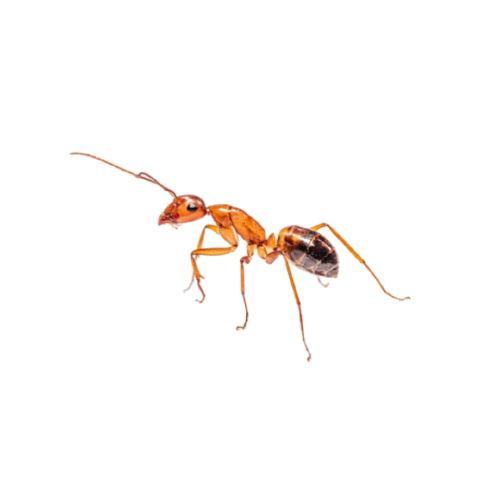Ants: Interesting Facts and Information
Learn methods for identifying and managing ants to safeguard your home and business.

Discovering the World of Ants
Ants belong to the Formicidae family and are considered one of the hardest-working insect species in the world. Although they may look similar, they exhibit distinct characteristics and appearances. Living in colonies with large numbers, they are referred to as eusocial insects, displaying a well-organized social structure where each member has its own unique role and responsibility. Ants can be categorized into three sections: The Queen, workers, and drones.
The Queen serves as the reproductive powerhouse of the colony, while worker ants, infertile females, are responsible for various tasks. Drones, or male ants, have the main responsibility of mating with the queen, after which they die.

Life Cycle of Ants
The life cycle of ants is truly captivating, unfolding in four distinct stages: the egg, larva, pupa, and adult stages. This incredible journey begins with the egg, which hatches into the larva stage. During the pupa stage, a remarkable transformation takes place, giving rise to a meticulously developed adult ant that makes invaluable contributions to the ant colony.
After hatching, the ant eggs enter the larval stage, during which worker ants provide necessary care and protection to the ant larvae.
Ants undergo metamorphosis and enter the pupa stage. Significant changes occur during this state, transforming the pupa into its adult form.
The adult stage is when the ant reaches full development and is ready to join the colonies, assuming responsibilities based on its species.
Types of Ants That Bite:
Some species of ants are known to bite. These include:

Dark brown or black in color, ¼ to ½ inch in length. These ants are well-known for their ability to build tunnels through wooden structures and are particularly attracted to sugary food sources.
Carpenter Ants
Reddish-brown in color. Measuring 1/8 to 1⁄4 inch in length. Fire ants possess a painful sting that can cause allergic reactions in some people.
Fire Ants
Light brown to black in color. 1/8 to ¼ inch in length. These insects are highly attracted to sugary substances.
Acrobat Ant
Glossy black in color. Measuring 1 to 1.5 inches in length. Bullet ants have earned their name due to the intense pain they inflict when they bite.
Bullet Ants
Dark black in color . ¼ to ½ inch in length. Notorious for causing nuisance and structural damages to properties.
Black Carpenter Ants
Red, brown or black in color. ¼ to ½ inch in length. They are capable of both biting and stinging, causing irritation or swelling.
Harvester AntsTypes of Ants that do not bite

Color: Dark brown to black Length: Approximately 2.2-2.8 mm. Argentine ants are attracted to sweet and sugary substances and exhibit aggressive behavior towards other ant species.
Argentine Ants
Color: Dark brown to black Length: About 2.4-3.3 mm. Odorous ants, as their name suggests, release an odor when crushed and also prefer sweet food sources.
Odorous Ants
Color: Brown to black Length: Approximately 2.5-3.2 mm. House ants are drawn to sweets and tend to build their nests in wall cracks and crevices
House Ants
Color: pale yellow to whitish Length: About 1.3-1.5 mm. Ghost ants are pale yellow and incredibly tiny, making them disappear quickly.They are aptly named due to their elusive nature.
Ghost Ants
Color: Yellow to light brown or red Length: Approximately 1.5-2 mm. These ants can be challenging to handle and have the potential to cause damage to wooden structures.
Pharaoh Ants
Color: Yellow to light brown Length: About 1.5-2.2 mm. Thief ants earned their name because they are known for stealing food sources from other ant colonies.
Thief AntsOvercoming Ant Infestation:
With over 12,000 different species found all over the world, ants, despite their small size, can cause serious infestations in our homes and businesses.To effectively combat ant infestations, implementing proper and effective pest control strategies is crucial.Recognized as one of the top-notch pest control services in Dubai, we employ a systematic and thorough approach to handle ant infestations. Our process begins with a detailed inspection, followed by continuous monitoring to ensure that all your pest issues are addressed accurately and effectively. At Al Rasa Pest control services in Dubai, we take pride in our team of experienced experts. Our services are available 24/7, providing you with a pest-free environment.
Frequently Asked Questions
Most ants are nuisances when they invade our homes, but they generally don’t damage our property. However, certain ant species like carpenter ants can cause damage over time.
Ants are attracted to food resources and leftovers, particularly sweet foods. If you leave food uncovered or forget to clean up leftovers, you are inviting ants into your home.
Using cheap chemicals from the market to control ants is not a good idea, as they may cause serious health issues for humans and pets. It is best to consult a professional pest control service to handle ant infestations.
Common signs of ant infestation include ant pits, visible ant trails, and dirt or sand near entry points.
Some interesting facts and informations about Ants
- Depending upon the ant species, they have different lifespans.
- Worker ants typically live for weeks to months, but this can vary based on environmental conditions and food availability.
- Queen ants have the longest lifespan, living for over one to two years, while male ants have the shortest lifespan.
- Ants often come indoors during the winter season to seek protection from the cold weather and find warmth.
- Ants communicate through chemicals, leaving trails to convey specific messages to other members of their colony and mark their territory.
- One fascinating fact about ants is that they can carry things that are 50 times their body weight.
- These hardworking insects can build large underground tunnels, connecting their colonies, and are often referred to as architects.
- It is interesting to note that some ant species practice slavery. They trespass into other colonies, take away larvae and pupae, and raise them as workers in their own colony.
- Ants have a long history on Earth, dating back more than 100 million years

Queen ants lay oval-shaped eggs and take care of them. These eggs are usually laid in underground nests or crevices, marking the first stage of the ant's life cycle.